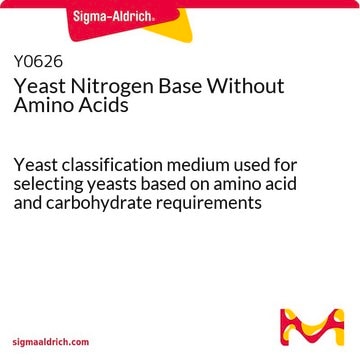All Photos(4)
About This Item
Linear Formula:
NaCN
CAS Number:
Molecular Weight:
49.01
Beilstein:
3587243
EC Number:
MDL number:
UNSPSC Code:
12352300
PubChem Substance ID:
NACRES:
NA.21
Assay:
97%
grade:
reagent grade
form:
powder, chunks or granules
Recommended Products
grade
reagent grade
Quality Level
vapor density
1.7 (vs air)
vapor pressure
1 mmHg ( 817 °C)
Assay
97%
form
powder, chunks or granules
pH
11-12 (25 °C, 49 g/L)
mp
563.7 °C (lit.)
SMILES string
[Na]C#N
InChI
1S/CN.Na/c1-2;
InChI key
RTVFYQXEHKQMKO-UHFFFAOYSA-N
Looking for similar products? Visit Product Comparison Guide
General description
Sodium cyanide is a hygroscopic salt and moderately strong base. It is soluble in water. Sodium cyanide is a strong nucleophile used to produce nitriles.
Signal Word
Danger
Hazard Statements
Precautionary Statements
Hazard Classifications
Acute Tox. 1 Dermal - Acute Tox. 1 Inhalation - Acute Tox. 1 Oral - Aquatic Acute 1 - Aquatic Chronic 1 - Met. Corr. 1 - STOT RE 1
Target Organs
Thyroid
Supplementary Hazards
Storage Class Code
6.1A - Combustible acute toxic Cat. 1 and 2 / very toxic hazardous materials
WGK
WGK 3
Choose from one of the most recent versions:
Already Own This Product?
Find documentation for the products that you have recently purchased in the Document Library.
Customers Also Viewed
Helen W Kreuzer et al.
Journal of forensic sciences, 57(1), 75-79 (2011-11-02)
Sodium and potassium cyanide are highly toxic, produced in large amounts by the chemical industry, and linked to numerous high-profile crimes. The U.S. Centers for Disease Control and Prevention has identified cyanide as one of the most probable agents to
Victor M Victor et al.
The Journal of clinical endocrinology and metabolism, 96(10), 3115-3122 (2011-07-23)
Insulin resistance is a feature of polycystic ovary syndrome (PCOS) and is related to mitochondrial and endothelial function. We tested whether hyperandrogenic insulin-resistant women with PCOS, who have an increased risk of vascular disease, display impaired leukocyte-endothelium interactions, and mitochondrial
Heterogeneously Catalyzed Oxidative Cyanation of Tertiary Amines with Sodium Cyanide/Hydrogen Peroxide using Polymer-Supported Iron (II) Phthalocyanines as Catalyst.
Singhal S, et al.
Advanced Synthesis & Catalysis, 352(8), 1338-1344 (2010)
Asymmetric cyanohydrin formation from aldehydes catalyzed by manganese Schiff base complexes.
Qu Y, et al.
Tetrahedron Asymmetry, 21(2), 187-190 (2010)
Copper (I) Bromide-Catalyzed Carbonylative Coupling of Aryl Halides with Phenols, Alcohols and Amines using Sodium Cyanide as C1 Source: A Synthesis of Carboxylic Acid Derivatives.
Prasad PK and Sudalai A.
Advanced Synthesis & Catalysis, 356(10), 2231-2238 (2014)
Our team of scientists has experience in all areas of research including Life Science, Material Science, Chemical Synthesis, Chromatography, Analytical and many others.
Contact Technical Service












